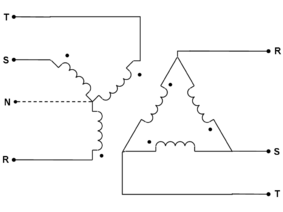Engineering:Delta-wye transformer
A delta-wye transformer is a type of three-phase electric power transformer design that employs delta-connected windings on its primary and wye/star connected windings on its secondary. A neutral wire can be provided on wye output side. It can be a single three-phase transformer, or built from three independent single-phase units. An equivalent term is delta-star transformer.
Transformers

Delta-wye transformers are common in commercial, industrial, and high-density residential locations, to supply three-phase distribution systems.
An example would be a distribution transformer with a delta primary, running on three 11 kV phases with no neutral or earth required, and a star (or wye) secondary providing a 3-phase supply at 415 V, with the domestic voltage of 240 available between each phase and the earthed (grounded) neutral point.
The delta winding allows third-harmonic currents to circulate within the transformer, and prevents third-harmonic currents from flowing in the supply line.[2]
Delta-wye transformers introduce a 30, 150, 210, or 330 degree phase shift.[3] Thus they cannot be paralleled with wye-wye (or delta-delta) transformers. However, they can be paralleled with identical configurations and some different configurations of other delta-wye (or wye-delta with some attention) transformers.[citation needed]
See also
- Electric power distribution
- High-leg delta
- Mains power systems
- Motor soft starter
References
- ↑ "Annex D - Three-phase transformer connections". IEC. http://212.175.131.171/IEC/iec60076-1%7Bed2.1%7Den_d.pdf#page=43.[yes|permanent dead link|dead link}}]
- ↑ Electrical Transmission and Distribution Reference Book, Westinghouse Electric Corporation, 1964, Chapter 5, table 15.
- ↑ "IEC Standard 60076-1 Edition 2:1993 consolidated with amendment 1:1999". IEC. http://212.175.131.171/IEC/iec60076-1%7Bed2.1%7Den_d.pdf#page=43.[yes|permanent dead link|dead link}}]
External links
 |



